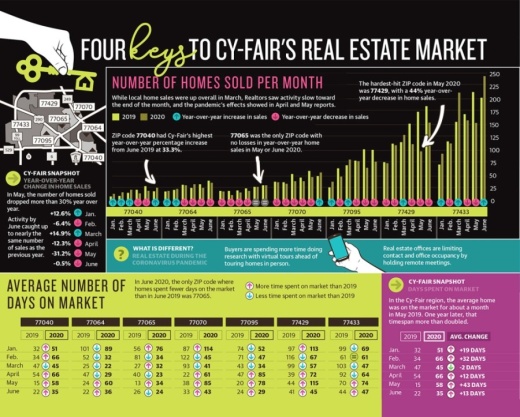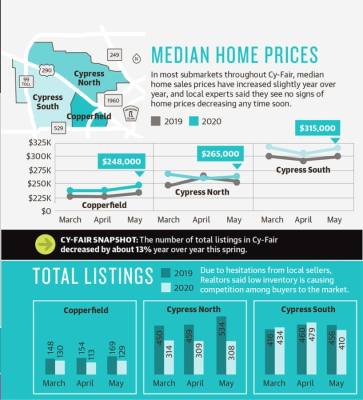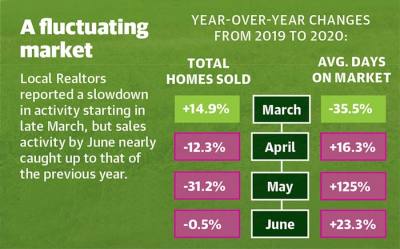But nearly flat year-over-year home sales in June reflect local real estate agents’ claim that business began to pick up when restrictions were lifted in May. They said they are hopeful increased activity will continue through the summer.
Debbie Marshall, manager and broker with Ross & Marshall Realty, said prior to the pandemic, she and her team projected an increase in sales and home prices in 2020. But once county and state officials issued stay-at-home orders in late March, activity in the local market came to a halt, she said.
“We really had no idea what to expect from this,” Marshall said. “In March, things came to a standstill a little bit. Then when things opened back up on May 1, honestly, it was like the floodgates opened, and we have been so busy.”
Her predictions for 2020 have partially come to fruition despite the pandemic, as median home prices are up about 2.4% since 2019. Cy-Fair home sales, on the other hand, were down year over year by 12.3% and 31.2% in April and May, respectively, but only three fewer homes were sold in June than June 2019.
Luis Torres, a research economist with the Real Estate Center at Texas A&M University, said the COVID-19 health crisis is unlike any other economic downturn the nation has experienced before, adding he expects to see “losses that overshadow” those of the Great Recession of late 2007 to 2009. In Texas, the economy is suffering even more due to the added effects of an energy industry decline, he said in a June 29 report.
According to data from Torres’ organization, total home listings decreased at least 13% in the Cy-Fair market this spring over last year. Low inventory combined with historically low interest rates make for a competitive market, experts said.
“The concern was all these people losing their jobs—especially [Houston] having the double whammy of the pandemic and oil prices taking a beating,” Cy-Fair Real Estate owner Jim Mulholland said. “The thought was mid- to late-summer [real estate activity] was going to really start slowing down, but that hasn’t happened yet.”
Local market declines
Mulholland mainly caters to master-planned communities in ZIP codes 77429 and 77433, including Bridgeland, Towne Lake, Cypress Creek Lakes and Fairfield. These ZIP codes saw a 12%-37% increase in year-over-year homes sales in March, but he said activity slowed toward the end of the month and through April before picking up again in May and June.
Mulholland said he believes the slowdown had nothing to do with a lack of demand from local buyers but rather a lack of supply from sellers.
“It seemed like the sellers were the ones that were more cautious. A lot of people didn’t want people coming into their house and were holding off on listing their house,” he said. “If you were willing and able to list your house, you were one of the few options a lot of buyers had.”
While data shows Cy-Fair home sales have decreased during the pandemic, Mulholland said homes have not stayed on the market long in his coverage area, and many sellers have had multiple offers to choose from—especially in the $250,000 price range.
For instance, in 77433, homes spent 30.4% less time on the market in April than in April 2019. However, by May, nearly every local ZIP code saw an increase in the average number of days homes spent on the market.
“June has just been so busy, but I think prior to that we had people holding off,” said Marshall, who works in neighborhoods such as Enchanted Valley Estates, Coles Crossing and Longwood. “We had people taking their homes off the market, people withdrawing [offers] temporarily.”
The real estate industry was also forced to tweak operations. Marshall said this included limiting occupancy in the office and carrying extra hand sanitizer and face masks for clients.
Ross & Marshall Realty also held virtual open houses, and buyers tended to do more research ahead of time. But Marshall said for the most part, clients were still willing to venture out to tour homes in person.
“We’re not seeing the virtual interaction as much,” she said. “Our clients are still wanting to touch, feel, smell the homes. If there’s something they’re interested in, they still want to go into the home.”
Enticing interest rates
While the summer months are typically a busy season for real estate agents, Mulholland said he is seeing increased competition as interest rates are at an all-time low. As of July 9, the U.S. average 30-year fixed mortgage rate was 3.03%, the lowest rate since the Federal Home Loan Mortgage Corp. began tracking data in 1971.
“We’ve actually had a few clients reach out to us who were thinking about refinancing, and because interest rates are so low, instead [they are] opting to actually upgrade,” Mulholland said. “And those people that were holding off to see what was going on with the coronavirus pandemic are now getting more enticed because of the interest rates being so low.”
In May, Bridgeland saw a 73% increase year over year in home sales over May 2019, according to Heath Melton, the executive vice president for master-planned community residential development at the Howard Hughes Corp. This number follows 24% and 63% year-over-year decreases in sales in March and April, respectively.
Melton attributes the increase in demand to the lifting of stay-home orders and lower interest rates.
“We saw people that may have been on the fence ... [decide] to make the home purchase as well as folks that might have been able to increase the budget that they were willing to spend on a house because interest rates came down,” Melton said.
Many who were previously hesitant to put their homes on the market moved forward with their plans in May when the economy began to reopen and low interest rates incentivized buyers, Marshall said.
She said some buyers are waiting to shop for homes because they believe sales prices will drop soon, but she sees no sign of that happening in Cy-Fair due to high demand.
“Typically, any kind of shift in the economic market is good for real estate—whether it’s a rise in our economy or a downfall or a natural disaster or a pandemic,” Marshall said. “When the economy is just average and moving along slowly, that’s when we tend to just have average sales, average markets.”
Future outlook
Area Realtors said they expect Cy-Fair’s market to remain strong through the summer while inventory and interest rates remain low, but it is difficult to predict what the long-term future may hold.
“I think everything’s shifted because the peak season’s typically March, April and May. I think it shifted to be May, June and—my guess is—July,” Mulholland said. “Right now, everything seems to be pointing upward, but you would think the economy would eventually have some kind of impact.”
Marshall said she anticipates the busy season lasting through August, but the future of the market will ultimately depend on how long the virus persists locally.
While many formerly furloughed workers have returned to some sense of job security since the spring, others could continue to lose their jobs and find themselves needing to sell their homes to make ends meet, she said. According to the Texas Workforce Commission, more than 40,000 Cy-Fair residents filed for unemployment benefits from mid-March to the end of June.
In late June and early July, state and county leaders began imposing new restrictions as the number of coronavirus cases confirmed grew. Torres said this could have negative effects on the market following the loosening of restrictions that took place in May.
“The recent upsurge in COVID-19 cases in Texas could hinder the rebound by decreasing mobility and spending,” Torres said.
Even so, Melton said he believes people are still interested in purchasing homes in Bridgeland. As individuals shop for homes, he said buyers are looking for flexible spaces that could be used as home offices should they spend more time working from home.
“Most of our builders were good about doing that already, but they’re taking a look at some of their floor plans just to make sure they can build that in,” he said. “I think most of us that are in the industry right now think that there could be a little bit more of organizations changing their thought process on [working] from the office full time versus some partial work from home.”







